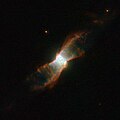Файл:NGC 6881 HST.jpg
NGC_6881_HST.jpg (532 × 532 пиксель, файлан барам: 129 Кб, MIME-тайп: image/jpeg)
Файлан истори
Тlетаlаде терахь/хан, муха хилла хьажарна и файл.
| Терахь/Хан | Жима | Файлан барам | Декъашхо | Билгалдаккхар | |
|---|---|---|---|---|---|
| карара | 2019, 31 декабрь, 09:13 |  | 532 × 532 (129 Кб) | BevinKacon | actual size from source |
| 2012, 12 март, 12:18 |  | 1280 × 1280 (266 Кб) | Jmencisom |
Файл лелор
ХӀара файл лахарчу 1 агӀонгахь лелош йу:
Глобалан файл лелор
ХӀара файл лелош йу лахахь гайтина йолу википедеш чохь:
- Лелор ar.wikipedia.org
- Лелор az.wikipedia.org
- Лелор beta.wikiversity.org
- Лелор be.wikipedia.org
- Лелор bs.wikipedia.org
- Лелор de.wikipedia.org
- Лелор diq.wikipedia.org
- Лелор en.wikipedia.org
- Лелор en.wikiversity.org
- Лелор eo.wikipedia.org
- Лелор eu.wikipedia.org
- Лелор fa.wikipedia.org
- Лелор fr.wikipedia.org
- Лелор hr.wikipedia.org
- Лелор kk.wikipedia.org
- Лелор lb.wikipedia.org
- Лелор mk.wikipedia.org
- Лелор my.wikipedia.org
- Лелор nl.wikipedia.org
- Лелор pl.wikipedia.org
- Лелор pt.wikipedia.org
- Лелор ru.wikipedia.org
- Лелор sk.wikipedia.org
- Лелор sr.wikipedia.org
- Лелор tr.wikipedia.org
- Лелор tt.wikipedia.org
- Лелор uk.wikipedia.org
- Лелор uz.wikipedia.org
- Лелор www.wikidata.org

